




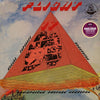
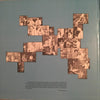
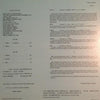
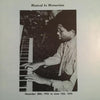
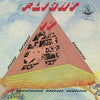
Horace Tapscott conducting The Pan-Afrikan Peoples Arkestra - Flight 17
ORDER LIMITED TO ONE ITEM PER CUSTOMER
Horace Tapscott - Piano, Conductor [click here to see more vinyl featuring Horace Tapscott]
Jesse Sharps – Soprano, Tenor, Bamboo Flute, Bandleader
Linda Hill – Piano
Adele Sebastian - Vocal, Flute
Lester Robertson – Trombone
David Bryant – Bass
Everett Brown Jr. – Drums
Herbert Callies – Alto Clarinet
James Andrews – Tenor, Bass Clarinet
Michael Session – Alto
Kafi Larry Roberts – Flute, Soprano
Archie Johnson – Trombone
Red Callendar – Tuba, Bass
William Madison – Percussion, Drums
Louis Spears – Cello, Bass
Kamonta Lawrence Polk – Bass.
1 LP, gatefold jacket
Limited edition
Original analog Master tape : YES
Heavy Press : 180g
Record color : black
Speed : 33 RPM
Size : 12'’
Stereo
Studio
Record Press : unspecified
Label : Pure Pleasure Records
Original Label : Nimbus West
Recorded in Los Angeles in 1978
Produced by Tom Albach & Horace Tapscott
Remastered by Ray Staff at Air Mastering, Lyndhurst Hall, London
Originally released in 1978
Reissued in 2021
Tracks :
Side A
- Flight 17
- Breeze
Side B
- Horacio
- Clarisse
- Maui
Awards:
Jazzwise Magazine Albums of the Year 2021 - Critics Poll 2021
Reviews :
“Other than half an album cut in 1969 for Flying Dutchman (which was shared with the John Carter/Bobby Bradford group), this release was pianist Horace Tapscott's recording debut as a leader. Tapscott's Pan-Afrikan Peoples Arkestra (consisting of two pianos, six reeds, two trombones, Red Callender on tuba, cello, two basses, a drummer, and a percussionist) had an unusual sound and made three records during 1978-1979. The band performs five group originals; surprisingly none were written by the leader. While there are some individual solos (particularly by Tapscott), it is the dense and frequently exciting ensembles that are most notable in this avant-garde but rhythmic music.” AllMusic Review by Scott Yanow
“When pianist Horace Tapscott emerged in the Central Avenue jazz scene in Los Angeles, he played with Don Cherry, Eric Dolphy and Billy Higgins. Part of his musical vision was to engage in collaborative and socio-political contexts. This led to the formation of a variety of cooperative large ensemble groups that reached a zenith with the creation of the Pan African Peoples Arkestra. Due to unfavorable conditions in South Los Angeles, the “Arkestra” performed in public parks and churches. Under Tapscott’s leadership, dozens of local musicians bonded for a decidedly ethnic-centered exploration that included politics and spirituality. These artists pursued a vision that distilled truth in art over commercialism. Also, the boundaries of the jazz genre were expanded and redefined. Nimbus West Records was the home label.
Pure Pleasure Records has released a pair (Flight 17, The Call) of 1978 Pan African Peoples Arkestra recordings, re-mastered to 180-gram vinyl. With a gifted, eclectic group of top-notch musicians, this “people’s orchestra” creates a unique vision of global jazz. Side A of Flight 17 opens with a free-form piano intro (including interior strings) with deep brooding and a sense of sophistication in Tapscott’s unique delivery on the title track. There is melodic intonation and subtle lower-register notation. When the band joins in, there is an up tempo repeat vamp with relentless fury. It feels widely experimental with free movement.The ensemble eschews soloing for staccato-like accents. But at the 14:08 mark, there is a soaring lyrical flute interlude with vibrato. Tapscott kicks off “Breeze” with a forceful, muscular solo that is soulful and resonant. The group joins in with a dream-inspired elasticity. Side B changes the dynamics with a finger-snapping percussion jam (“Horatio”) whose rhythm and flute accents conjure up West African motifs. Then, they engage in a festive up tempo translation with syncopated aesthetics and time changes. It is more cohesive and intermingles traditional jazz styles including hard bop. Tapscott’s breezy piano lines are hypnotic and are fueled by the in-the-pocket band play and Cuban-inspired agility. “Clarisse” is more ethereal and arranged with a focus on horn/reed textures. There is a slower blues vibe that morphs into bebop freneticism. A smoky saxophone and double bass keep the bluesy edge and jazzy energy. A saucy trumpet and female vocal brings an edgy grittiness to the jam. “Maui” is anchored by another vamp with flute and double bass. Here, the brass is prominently featured in the arrangement. After the swing mode, there is a melancholy interlude before the return to higher energy. There is a bop-like saxophone that adds color.” Robbie Gerson, Audiophile Audition, October 2021
"Horace Tapscott's Pan-Afrikan Peoples Arkestra (P.A.P.A.) was one of the most transformative, forward-thinking and straight-up heavy big bands to have played jazz in the 1960s and 1970s. If P.A.P.A. doesn't have the interstellar rep of that other famous Arkestra, and if the name Tapscott doesn't ring bells like Monk or Tyner, there's a reason why: in an industry dominated by record labels, a band that doesn't record doesn't count. And the Pan-Afrikan Peoples Arkestra didn't record for nearly twenty years. But recording success was never their concern — they weren't about that. First formed as the Underground Musicians Association in the early 1960s, Tapscott always wanted his group to be a community project.
"From their base in Watts, UGMA got down at the grassroots. The group was renamed the Pan-Afrikan Peoples Arkestra in 1971, and soon after they established a monthly residency at the Immanuel United Church of Christ which ran for over a decade, while still playing all over LA and beyond. But they never released a note of music. It was the intervention of fan Tom Albach that finally got them on wax. Determined that their work should be documented, Albach founded Nimbus Records specifically to release the music of Tapscott, the Arkestra, and the individuals that comprised it. The first recording sessions in early 1978 yielded enough material for two albums, and the first release was Flight 17. The album commences with the magnificent title track. It is effectively in three parts. It begins with unaccompanied pianos. Then the ensemble embark on a dense, circular and mechanical movement, a platform for horns and pianos to swoop and dive. We return to Earth with a beautiful solitary flute.
"The second track, the piano-centric, ‘Breeze' is different to ‘Flight 17' in intensity and also brevity but it is quietly as daring as the title track. It concludes with a moving lush wash from the full Arkestra, which sound almost like strings only more substantial. These first two tracks take full advantage of the texture of the unusual mix of the various instruments. Next though, it's a significant change with ‘Horacio', which is an exuberant Latin infused jingle. It's unlike anything else on the album. I like to think it was named after the conductor's Cuban alter-ego! ‘Clarisse' gracefully switches between slow blues and bop and is bookended with a grand vaguely East Asian theme. The busy bass line introduces ‘Maui'. As with the previous track, it moves between a number of contrasting melody lines and rhythms but there's still space for a tuneful sax solo.
"This is a must-have album. I think the first two tracks on their own make this release essential." — Kevin Ward, U.K. Vibe/Boomkat
Ratings :
AllMusic : 4 / 5 ; Discogs : 4.67 / 5 ; Audiophile Audition : 4.5 / 5




